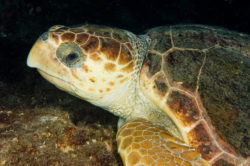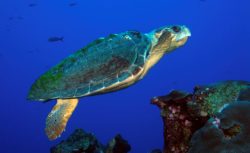
Sea Wonder: Loggerhead Turtle

This loggerhead sea turtle was handing around the wreck of the tanker Ashkhabad. The Ashkhabad was sunk by a German U-boat during World War II and now rests in the Graveyard of the Atlantic. Ashkhabad is one ship that could be protected by an expanded Monitor National Marine Sanctuary. Photo: NOAA
Loggerhead turtles (Caretta caretta), named for their large heads that support their powerful jaws, are one of seven sea turtle species that call the world’s ocean home. Six of seven species are found in U.S. waters and all six are listed and protected under the Endangered Species Act. They are a migratory species that lives in many parts of the global ocean and their nests are the most abundant sea turtle nests found in the United States.
Description
Loggerhead turtles have a heart-shaped shell that is red-brown on top and pale yellow on the bottom. Adults average a maximum length of three feet and weight of 250 pounds, though some individuals have weighed as much as 400 pounds! They have two foreflippers and two hindflippers; their heads and flippers are pale yellow with dark brown spots. Unlike freshwater turtles and tortoises, they cannot withdraw their head into their shells. They are reptiles, which means they are cold blooded and can survive in cool and warm waters. They do not have gills but instead travel to the ocean’s surface to use the nostrils located at the end of their bills to breathe air.

This loggerhead sea turtle was spotted in Flower Garden Banks National Marine Sanctuary. Photo: G.P. Schmahl/NOAA
Diet & Habitat
Loggerhead turtles are carnivores that feed on other marine animals. Their diet commonly includes crustaceans, fish, and invertebrates found on the seafloor. The turtles’ powerful jaws help them trap and crush their prey before swallowing it whole. On rare occasions, plant matter is found in the stomachs of loggerhead turtles but is likely something they accidentally ingest if feeding on organisms that take shelter among marine plants rather than something they actively graze on.
Loggerhead turtles are wide-ranging, highly migratory and skilled navigators. They mate in the open ocean every two or three years and then travel to the same nesting sites at which they were born to lay their own eggs. They spend the rest of their time foraging throughout the ocean, sticking to areas where food is abundant. They live in temperate, subtropical, and tropical waters in the Atlantic, Indian, and Pacific Oceans, as well as the Mediterranean Sea. In the Atlantic, we see loggerhead turtles as far south as Argentina and as far north as Canada. In the Pacific, loggerhead turtles range from Washington state down to Mexico, as well as along Japan and other parts of Asia. The largest concentration of loggerhead turtle nests is found in the United States from North Carolina to Florida, with most nesting activity occurring on Florida’s central Atlantic coast. Throughout the National Marine Sanctuary System, we might see loggerhead turtles in or near all of the oceanic sanctuaries, but most commonly Gray’s Reef, Florida Keys, and Flower Garden Banks.
Life History
Loggerhead turtles begin their lives after nearly three months of incubation, breaking out of their eggs and digging out from their buried nests. Tens of thousands of hatchlings emerge from the sandy beaches and make their way to the ocean to begin their lives. Few will survive the trip to the water and even fewer will survive into adulthood, which is why females lay so many eggs at a time. For the first seven to 15 years of their lives, juvenile turtles stay in the open ocean, migrating to coastal areas to forage. They are generally solitary animals that only socialize on occasion. Once they reach maturity, they will begin looking for mates every few years and traveling back to their original nesting grounds. Loggerhead turtles can live to be upwards of 80 years old, though their average lifespan does appear to be decreasing.
In a single nesting season, adult females will usually dig three to five nests, two weeks apart, each nest containing about 100 eggs. To reduce the risk of predators knowing the location of their nests and feeding on the eggs, females dig their nests and lay their eggs at night. Adults do not stay to incubate the nests but let the sand in which the eggs are buried incubate them. The sex of the hatchlings is not genetically determined, but by the ambient temperature of their nest during development. Warmer sands produce females and cooler sands produce males, which is one reason a warming global climate puts loggerhead turtle populations at risk of decline.
Threats & Conservation
Loggerhead turtles are listed as endangered under the United States’ Endangered Species Act, as an Appendix I species under the Convention on International Trade in Endangered Species of Wild Fauna and Flora (CITES), and vulnerable on the International Union for Conservation of Nature (IUCN) Red List. The most significant threat to loggerhead turtles is entanglement in fishing gear, which leads to drowning. The invention and use of Turtle Excluder Devices (TEDs) by fishing vessels have helped reduce sea turtle bycatch in some fisheries but still remains a present threat to the species worldwide. Loggerhead turtles also mistake floating debris for food, which can lead to digestive problems and starvation. Hatchlings are at risk of predation and artificial light produced by coastal communities, which prevents them from finding the ocean when they hatch. Other threats include ship strikes, habitat loss, and egg harvesting by humans.

A loggerhead sea turtle swimming in Flower Garden Banks National Marine Sanctuary. Photo: Frank Burek
